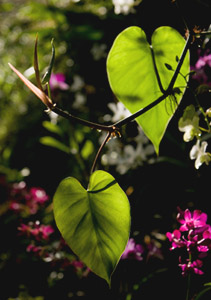 Hi everyone, Makaira here! I hope you’re all keeping healthy, happy and enjoying the frosty days! Though on Hawaii it never gets too chilly, I often find the changing weather can be tough on our beloved kava plants as the sun recedes and the winter rains set in. On the farm, we all have to work hard to nourish and care for our plants in their entirety, from roots to vines to leaves. The challenging physical work of managing the farm often makes me contemplative, and lately I’ve been mulling a question many of you out there may also have—are kava leaves good for anything?
Hi everyone, Makaira here! I hope you’re all keeping healthy, happy and enjoying the frosty days! Though on Hawaii it never gets too chilly, I often find the changing weather can be tough on our beloved kava plants as the sun recedes and the winter rains set in. On the farm, we all have to work hard to nourish and care for our plants in their entirety, from roots to vines to leaves. The challenging physical work of managing the farm often makes me contemplative, and lately I’ve been mulling a question many of you out there may also have—are kava leaves good for anything?
Of course, such a question immediately reveals a humanisitic bias: after all, kava leaves are essential to the life of the plant; they provide it energy and nourishment through the miracle of photosynthesis! Yet leaving aside this obvious point, I began to wonder if I have discounted the value of the whole kava plant in favor of its undeniably remarkable root: at Kona Kava Farm, we have devoted so many words to guaranteeing that our kava is root-only and contains no stem peelings or leaves that it gives an impression—inadvertent, I assure you—that kava leaves have no value or use in South Pacific societies. Yet it turns out that, even though they are never used to brew kava or otherwise consumed internally, kava leaves do have traditional medicinal uses in Hawaii and other regions of the South Pacific.
I personally believe kava to be a very beautiful plant, and this is nowhere more evident than in its large leaves: shiny, green, and heart-shaped, kava leaves reflect the love and goodwill this plant bears toward those who listen to her teachings. Call me a New Ager, but that’s what I believe! Happiest in humid, jungle environments, kava can grow from 6 to 8 feet tall in the understory below the jungle canopy, and prefers partial shade to direct sunlight. You know kava is happy and ready to be harvested when it has grown tall and put out lots of leaves, so that it resembles a cylindrical shrub.
In Hawaii, almost every part of the kava plant is used for something, and kava leaves are no exception. Like kava root, the leaves are strongly antimicrobial and also have anti-inflammatory properties, good for soothing irritated, inflamed and infected skin. Traditionally, kava leaves have been crushed into a poultice and rubbed into the skin to treat rashes, insect bites and stings, and fungal skin conditions such as dermatitis and ringworm. Through centuries of keen observation, Hawaiians have discovered this beneficial effect of kava leaves and ensured that no part of the kava plant goes to waste!
So, how did kava leaves get a bad reputation in the first place? As some of you may recall, there was a debate in the mid-2000s about the factors behind the later-debunked claim that kava might be harmful to the liver. I’ve discussed this elsewhere on my blog, but suffice to say the claim of liver damage was struck down by later studies that examined subjects who had consumed only aqueous (water-based) extracts of kava kava made from the plant’s roots, which is the way the root is traditionally prepared in the South Pacific. The early case studies were based on subjects who had combined kava with alcohol, benzodiazepines, and other drugs, and these studies are now widely considered to be hopelessly flawed. These early, flawed case studies also revealed that some unscrupulous kava manufacturers had used kava leaves and stem peelings in the kava extracts that were examined, and that this material may have also contributed to the cases of liver injury studied.
Why is this? Well, the culprit is probably a compound called pipermethystine that is found in kava leaves, as well as the aerial stem and bark of the plant. Nonexistent in kava’s roots, pipermethystine can be concentrated in kava’s aboveground parts to an amount of 200 parts per million. Lab experiments have shown that pipermethystine demonstrates toxic activity in cultured liver cells, whereas the kavalactones found in kava’s roots are nontoxic and safe for the liver.
Kava is an extremely chemically complex plant, and no one thing can be called the “smoking gun” explanation for the liver damage that arose in the 2000 studies. The concomitant mixing of kava with alcohol and/or depressant drugs, and the use of ethanol and hexane kava extracts that were not full-spectrum, and the use of kava leaves in these preparations likely all played a role. Kava leaves and stems are never used to make a traditional aqueous kava brew, and there is clearly good reason for that avoidance. When a plant medicine has been used for thousands of years, as kava has in the South Pacific, it’s always the path of wisdom to listen and pay attention to how the indigenous people use it and model our own behavior accordingly!
Yet it is perhaps equally unwise to discount the usefulness of the whole plant, simply because one part of it has a more common or broader use than the others. Inviting a sense of the holistic value of the medicinal and sacred kava kava, in all her aspects, can help us appreciate our relationship to her even more deeply and lovingly than before. Wishing everyone wholeness and happiness in the new year,
Aloha no,
Makaira





